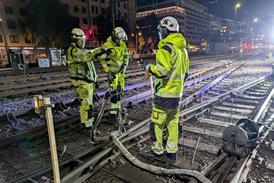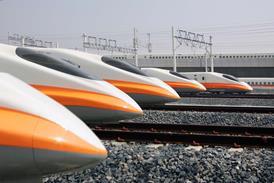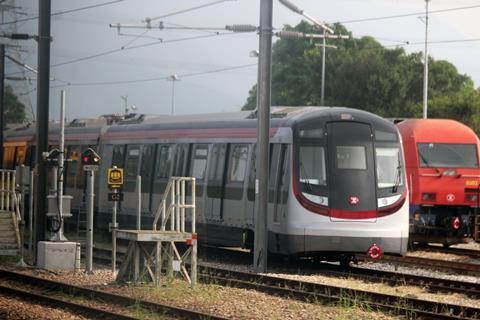
CHINA: The first of 43 nine-car EMUs being built for MTR Corp by Hyundai Rotem finally entered service on Hong Kong’s East Rail Line between Hung Hom, Lo Wu and Lok Ma Chau on February 6.
Introduction of the R-trains had been dependent on the successful commissioning of a new communications-based train control system; a planned launch on September 12 had been called off at the last minute after earlier testing revealed problems with the route-setting software.
The 41 km former Kowloon – Canton Railway main line has been equipped with Trainguard MT under an HK$850m contract awarded to Siemens in December 2012, which has already seen control of the route transferred to MTR’s Operations Control Centre in Tsing Yi. The work is an enabling measure for the second phase of the Shatin – Central Link, which will see East Rail extended by 6 km from Hung Hom under Victoria Harbour to Admiralty on Hong Kong Island.
Shorter but more frequent trains
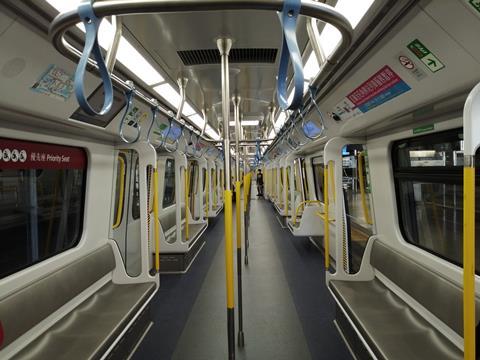
A HK$4bn contract for 37 R-trains was awarded to Hyundai Rotem in December 2012, and last year MTR exercised an option for a further six.
The first trains to enter service have displaced the SP1900 sets supplied by Kawasaki Heavy Industries in 2001. These are to be modified for use on the east-west Tuen Ma Line, joining similar vehicles supplied for West Rail and the Ma On Shan Line. The remaining R-trains are expected to be phased in by early 2022, replacing the life-expired EMUs supplied by Metro-Cammell for the 25 kV 50 Hz KCR electrification in 1981.
MTR’s decision to replace the existing 12-car EMUs by nine-car formations has been controversial, but the operator argued that CBTC would allow operation at shorter headways than the 2 min to 3 min allowed by the previous signalling. The through-gangwayed trains have a slightly wider body profile and longitudinal seating at the car ends to provide more standing space. One vehicle provides first class accommodation. More evenly spaced doorways are expected to speed boarding and alighting, and will facilitate the future installation of platform screen doors at East Rail stations.
MTR Deputy General Manager Chan Lam-sang told the region’s Legislative Council on February 1 that some older 12-car trains would continue to operate pending the introduction of the remaining new stock. Extra staff would be deployed to assist the passengers in transitioning to the new arrangements, along with additional signage and announcements at the stations.
Signalling problems delay SCL completion
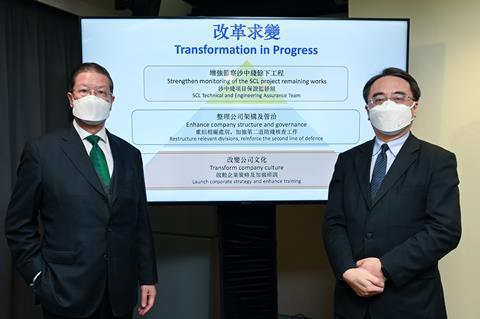
MTR Corp had announced on February 1 that testing of the new East Rail signalling had been satisfactorily completed, ready for the start of ‘mixed-fleet operation’. This followed a detailed technical investigation into the route-setting software problems discovered last May, and an independent review about how the issue had been handled in the run-up to the last-minute decision to postpone the September launch.
In a report published on the same day, the review panel told MTR that the project team and contractor ‘should have realised there were additional underlying root causes which were more complex … it was an error of judgement not to carry out a more detailed investigation earlier’.
The Hong Kong government expressed its ‘grave disappointment’ that the CBTC commissioning problems may further delay completion of the chequered SCL project which is now expected to cost HK$90bn.
The final section of the east-west Tuen Ma Line between Kai Tak and Hung Hom is now expected to open later this year. However, MTR Corp CEO Jacob Kam admitted that the signalling problems might further delay the opening of the cross-harbour extension from Mong Kok to Admiralty via low-level platforms at Hung Hom. This is currently anticipated for the first quarter of 2022.
‘Whenever there is a delay on the critical path, that means there will be a delay to the overall programme’, he told local media. ‘There will be an impact. Of course we want to open it as soon as possible.’
Meanwhile, MTR Corp has decided to establish a dedicated SCL Technical & Engineering Assurance Team, ‘directly accountable to the CEO’. This will monitor the project from both the technical and service readiness perspectives, in order to identify any ‘important unknown issues’ with the remaining stages and ensure a timely follow up.
Both the new trains and the new signalling system will begin serving East Rail Line from 6/Feb (Sat) @Siemens has made numerous amendments to the signalling system in collaboration with #MTR Corporation in order to prevent any potential inconvenience to passengers pic.twitter.com/JrFLWRP4zO
— MTR Service Update (@mtrupdate) February 3, 2021
